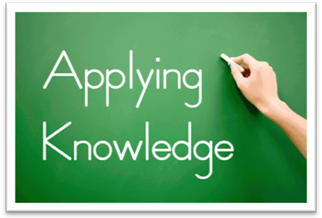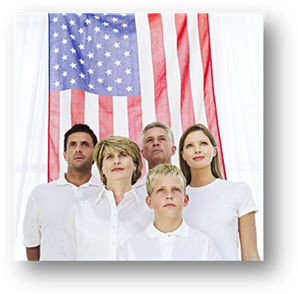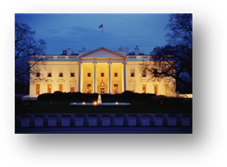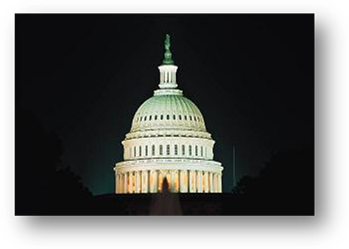APPLYING
KNOWLEDGE

Unit Overview
You have learned about a variety of topics so far in this course. In this unit you will apply your knowledge through activities and testing.
Case Study
Read the following case study that was
written in 2002. Be prepared to answer
questions regarding the study in the questions section of this unit.
Cultural Conformity
and Adaptation: Nationalism
Among the core values that help define
American culture are nationalism and patriotism. In the wake of September 11, 2001, renewed
signs of nationalism were everywhere.
According to one journalist, “the American flag was hard to miss. It flew from flagpoles, stuck out of
mailboxes and covered car windows.
Bumper stickers, T-shirts, and lapel pins proudly burst with red, white,
and blue. People waved the flag, wore
it, and perhaps even made judgments about those who did not.”

The Pew Research Center is an independent
opinion research group best known for regular national surveys which measure
public attentiveness to major news stories, and for its polling which charts
trends in values and fundamental political and social attitudes. The following report looks at how public
opinion about the nation changed during the six months following the September
11, 2001 terrorist attacks on America.
Public Opinion Six Months
Later: Nationhood, Internationalism
Lifted
The events of September 11 affected public opinion more dramatically than any event since World War II. Clearly the attacks brought unparalleled national unity and patriotism, but perhaps more importantly and more enduringly, they once again elevated the importance of nationhood. Washington, the federal government, and even its political leadership have new relevance post-9/11.

To many Americans in the late 1990s, the national government, if not the nation-state itself, appeared irrelevant and floundering. The seeming absence of an overseas threat to the country, the surging stock market driven by the emergence of a global Internet, and a policy emphasis on devolution to the states diminished the importance of the nation. Throughout the decade, Pew surveys found Americans saying that they were personally optimistic, but much less satisfaction and optimism were expressed about the nation. In Campaign 2000 nearly one-third of voters said that who’s elected President is not so important. The September 11 attacks stopped these sentiments in their tracks.
Pew’s
nationwide survey in January 2002 found twice as many Americans as in previous
years thinking that the President’s State of the Union address would be
especially important. And
 The
public’s trust in government, which was mired in the 30% range through much of
the 1990s, doubled in the wake of the attacks.
That measure has since softened, but a CBS News/New York Times survey in
January 2002 found 46% still saying that they trust the government at least
most of the time. Similarly, the
President’s ratings continued at unprecedented levels, and the rising tide of
opinion was reflected in an improved opinion of Congress as well. In part, these changes were an expression of
the country pulling together and thus appeared likely to fade a bit over
time. But they also reflected a clear
awareness of the government’s new roles—to provide protection at home and wage
war on enemies abroad. Several Pew
Research Center surveys that were conducted from October 2001 through January
2002 underscored this theme. Support for
increased defense spending stood at 60%, nearly triple the level of 1998, while
funding for terrorism defenses at home won even more backing.
The
public’s trust in government, which was mired in the 30% range through much of
the 1990s, doubled in the wake of the attacks.
That measure has since softened, but a CBS News/New York Times survey in
January 2002 found 46% still saying that they trust the government at least
most of the time. Similarly, the
President’s ratings continued at unprecedented levels, and the rising tide of
opinion was reflected in an improved opinion of Congress as well. In part, these changes were an expression of
the country pulling together and thus appeared likely to fade a bit over
time. But they also reflected a clear
awareness of the government’s new roles—to provide protection at home and wage
war on enemies abroad. Several Pew
Research Center surveys that were conducted from October 2001 through January
2002 underscored this theme. Support for
increased defense spending stood at 60%, nearly triple the level of 1998, while
funding for terrorism defenses at home won even more backing.
Interestingly, 9/11 did not cause the public to abandon its longstanding criticisms of government. A November 2001 survey by the Pew Research Center found more than half of respondents holding the view that government was too wasteful and controlling, with nearly as many expressing doubt about the trustworthiness of government officials. In fact, the dominant theme of the post-9/11 era was not that the public likes government more— rather it needed government more. This may have slowed a return to a hypercritical attitude toward government, even if feelings of national unity faded.
Politically, in January 2002, there were signs that the nation was returning to a more typical environment. Satisfaction with national conditions, while still high in historical terms, dropped a little. Also, ratings for Congress and even President Bush dropped. But the President was still rated positively by nearly eight-in-ten Americans and had an extraordinary 63% approval mark among Democrats in Pew’s February 2002 survey. Tough congressional fights over energy, taxes, and the deficit, and proposals to reform campaigns and elections later brought about a more partisan response.

Public Opinion Eight Years After
9/11: Have Americans’ Beliefs Changed
from 2002 to 2009?
As part of the United States’ effort to eliminate threats to
national security, Americans, who once supported every effort to invade foreign
enemies, doubted that the government made the right decisions. In 2009, the
This growing pessimism became visible on Capitol Hill too. In September 2009, Nancy Pelosi, the Speaker of the House of Representatives, warned that neither Capitol Hill nor ordinary voters were in the mood for sending more soldiers to a war that had already taken almost 900 American lives –51 in August 2009 alone. Also, in September 2009, Michigan's Carl Levin, chairman of the powerful Senate Armed Services Committee, declared that the US should send no more troops before a "surge" in Afghan security forces. But as even Pentagon officials concede, training Afghan forces up to the required standard of competence – not to mention loyalty – will be even more difficult than it was in Iraq.
Furthermore,
in 2009, our country was facing a recession and health care concerns. People were out of work, out of money, and
scared about their future. This had
greatly affected people’s confidence in our government. In a September 2009 Pew Research Center Poll,
people’s views showed the frustration. Americans were extremely displeased with
Congress, and there were already some signs that this could take a toll on the
Democrats in the 2010 midterm elections.
In late 2009, 37% expressed a favorable opinion of Congress, while 52%
held an unfavorable view. Positive opinions of Congress declined by 13 points
between April 2009 and September 2009, dropping to one of their lowest points
in more than two decades of Pew Research Center surveys.

President Obama and his handling of the
economy, health care, and the war in Iraq and Afghanistan had also led to
frustration among Americans. A
September 2009 Pew Research Center Poll showed that in April 2009, 62% of the public
approved of Barack Obama's performance as President, and 26% disapproved. In
August 2009, just four months later, 52% approved of Obama's job performance,
while 37% disapproved. Obama's approval rating declined across nearly all major
demographic and political groups. It had
fallen 11 points among women and nine points among men; by 12 points among Republicans,
10 points among Democrats, and nine points among independents.
Interview Process

Complete the following interview process, and be prepared to answer questions regarding it in the questions section of this unit.
Interview the following four people:
· a person who is in the Early Adulthood age (17-22 yrs)
· a person in the adult phase OR age 30 transition (ages 23-27; 28-32)
· a person in the settling down phase OR mid-life transition (ages 33-39; 40-44)
· a person in their golden years, young old or middle old (ages of 65-74; 75-84)
You are to interview a total of four people. Here are the questions that you are to ask:
1. What are your career goals?
2. What are your goals in terms of marriage and family?
3. What are your views on being successful in life?
4. Where do you see yourself 5 or 10 years from now?
5. What are three things in life that you need to make you happy?
In the questions section of this unit, you will be
asked review questions from the first eight units of this course. Before answering those questions, be
sure to review Units 1 through 8. Study
the major theorists, the major concepts, and definitions.
|
|
Now stop and answer
questions 1 through 50. |
